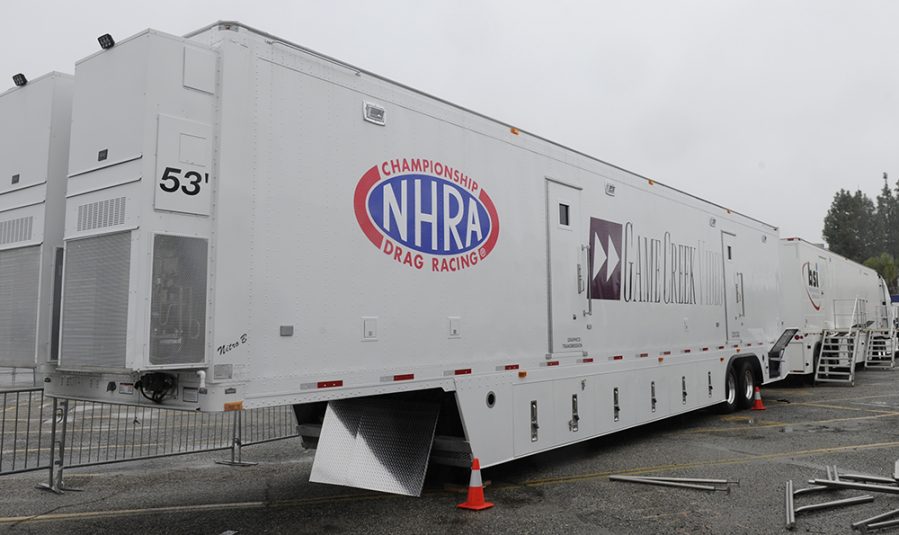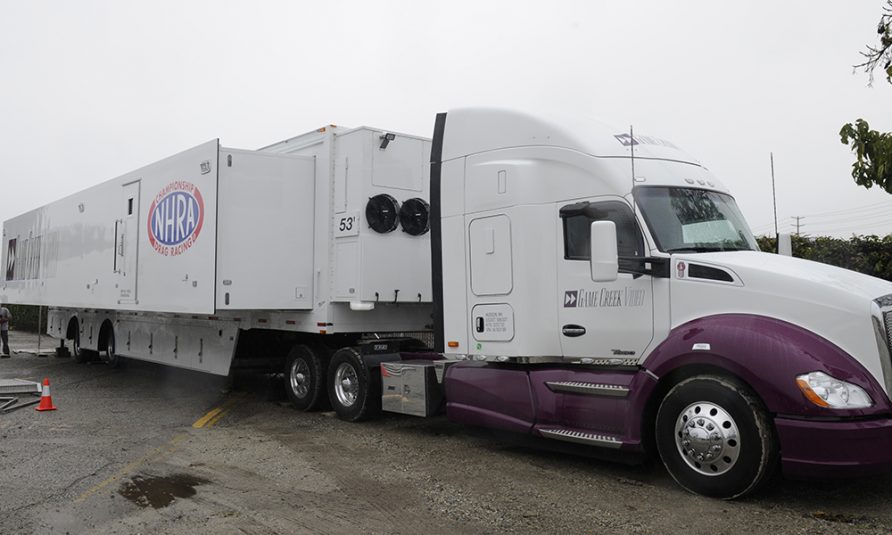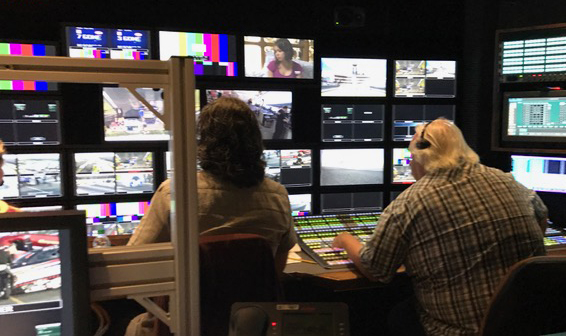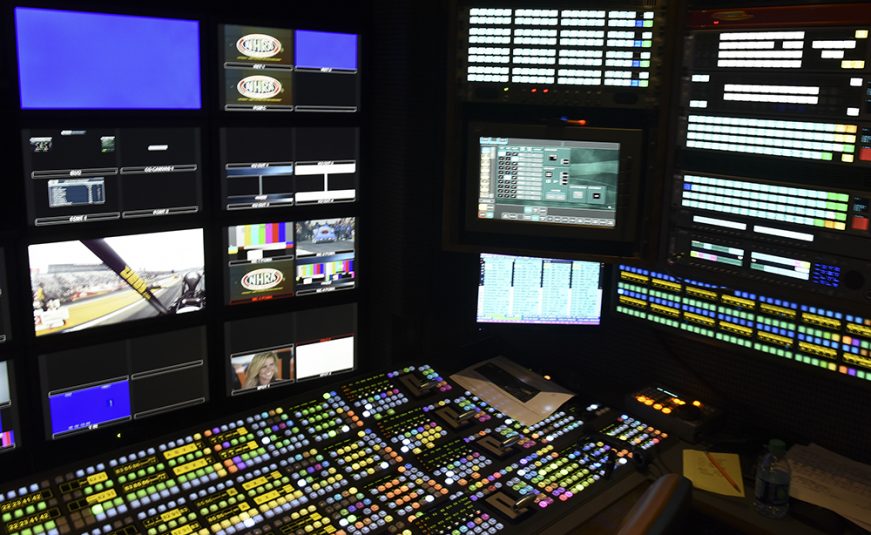NHRA Roars Out With Big Ratings, Enhanced Production Complement
Year two of Fox Sports deal sees new Game Creek truck, a Sony HDC-4800 camera, more SMT virtual graphics
Story Highlights
The 2017 NHRA season burned some ratings rubber during its opening weekend: the Mello Yello Drag Racing Series logged its most watched broadcast in its 57-year history. During the three-hour live broadcast on Fox on Feb. 12, 1.22 million viewers watched as fan favorite Leah Pritchett secured her second career Top Fuel win at the Circle K NHRA Winternationals. With more eyeballs on the NHRA track than ever, the organization continues to ramp up production quality in year two of its long-term rights deal with Fox Sports, adding a new Game Creek Video mobile unit, a Sony HDC-4800 16X ultra-slo-mo camera, virtual graphics courtesy of SMT, and more.

Game Creek Video designed the new Nitro mobile unit specifically with NHRA’s live productions in mind.
“There is nothing like being there at an NHRA event,” says Ken Adelson, VP/executive producer/chief content officer, NHRA, which brought its production operation in-house last year. “We are trying to bring that to life on television. I think we learned a lot about how to do that in year one [of the Fox deal].
“The pace of production in the truck [for NHRA] is unlike anything else,” he continues. “We are cutting five hours down to three on the fly. Some of my colleagues at Fox equate it to producing golf because there’s so much going on in so many places at once. You can’t produce this like a stick-and-ball sport; it’s just not the same. We believe we now have the tools and technology necessary to tell the best possible stories.”
Nitro Enters the NHRA Fold
With so much drag-racing action occurring at once on an average weekend, the NHRA required a nimble mobile unit capable of adapting to its needs. Game Creek Video has created just that with NHRA’s new 4K-capable Nitro mobile unit: a double-expando A unit (housing the main production team) and a non-expanding B unit (housing a production team focused on the in-venue production, an audio submix area, and the equivalent of a master-control area for playout of previously recorded events).
“The truck gave us the canvas and the tools to execute a lot of the things that we wanted to do,” says Adelson. “We were thrilled with how it performed right out of the box. And I don’t think we have tapped its potential yet in terms of capacity and horsepower. We have a great crew, and, as they get used to it even more, we’re going to find more and more ways to take advantage of it where it’s really noticeable on the air.”
The A unit features a front bench along the side of the truck (rather than facing the end of it) and is equipped with a Grass Valley Kayenne K-Frame production switcher, Calrec Artemis audio console, Evertz EQX baseband video router and EMR audio router, Boland video monitors (in both units), EVS XT3 replay servers, and Sony HDC-2500 cameras.
Adelson considers Nitro’s 5.1-surround-sound capability and additional EVS channels the key differentiators this year for NHRA’s weekly productions.
“The truck that we had was a very good truck, but it was at the end of its life. We didn’t have the ability to do the 5.1 surround last year with that truck,” he says. “That’s a significant advantage we have now, because the sounds of this sport are a huge part of the appeal and what makes it special.
“Having more channels of EVS is also incredibly important,” he continues. “We did find ourselves somewhat limited last year on the amount of horsepower that we had with our replay EVS channels. This year, it’s not an issue at all.”
Sony HDC-4800 Takes Slo-Mo to the Next Level
The average NHRA production features 20 cameras, including a jib, a pair of in-car cams, six handhelds, four hard cameras, and seven robos — plus an aerial chopper when available.
New for NHRA coverage this year is a Sony HDC-4800 camera, which is capable of showing cars hitting speeds of more than 300 mph in breathtaking 16X slow motion in HD (8X in 4K mode). The HDC-4800 is deployed as an iso camera at the 1,320-ft. finish line to capture dramatic shots of the action.
“Being able to capture these amazingly fast cars in extreme slow motion is very important because you actually can see things with the slo-mo that you just don’t see with the naked eye: the tires expanding and action with the cylinder heads, for example,” says Adelson. “The HDC-4800 is the most powerful technology available for high-speed capture, so it’s amazing what this camera can bring to the viewer: it’s showing us things that we have only talked about in the past. That level of high speed is great for all sports, but, for this sport, it helps make the show something special.”
In addition to the HDC-4800, NHRA has added a pair of trackside Marshall POV robos courtesy of Inertia Unlimited (which also provided a single point of control for them).
“The quality of those POVs is just amazing,” says Adelson. “There are always POVs, but now you can integrate them into an HD broadcast, and you’re not dealing with any diminished resolution.”
Going Virtual: SMT Graphics Play Key Role in Storytelling
Last year, NHRA added SMT virtual graphics (originally supplied by Sportvision, before it was acquired by SMT last fall) to its telecasts, including virtual start and finish lines, as well as player cards identifying drivers in their respective lanes with virtual name-and-headshot graphics on the asphalt in front of the car. Those virtual player cards are hugely important to a sport that features four classes and is attempting to educate new fans about the sport and its drivers.
“SMT was a great addition last year, and I think people are going to see even more this year,” says Adelson. “Now SMT is also working with us on some other car tracking, virtual ways to get more visual information on the screen that is not just another set of numbers. We want to display things about matchups and some of the stats and some of the important facts in a way that you can’t do without being virtual.”
More Than Just the Races: Launching a 24/7 News Operation
When the NHRA brought its production operations in-house prior to last season, one of its top goals was to build out a full production facility at its Glendora, CA, headquarters and a dedicated news bureau in Indianapolis (home to nearly all NHRA team operations). Operations at those facilities are well under way, with a full studio in Glendora producing daily programming, such as NHRA Today segments, for NHRA.com and other media outlets.

Nitro rolled out last fall for various clients but is now home to NHRA coverage throughout this season.
“We produce everything from daily NHRA Today segments to Crew Chief Confidential to driver segments, which gives us a chance to get out to Indianapolis follow up on the stories that happened in the shops,” says Adelson. “We are now a true 24/7 all-year operation. We don’t just appear every other weekend on TV.”
The NHRA also redesigned NHRA.com and rededicated itself to better serve its social-media channels. The goal of both digital and linear-television efforts is to transform NHRA from a niche sport historically shown in tape delay on cable into a live, multiplatform property that appeals to both hardcore and mass audiences alike.
“Here’s the big difference between this year and last year: last year, we were building everything; this year, it’s built, and we’re using it,” says Adelson. “I think we’ve had great success already with the content that’s been out there, and you’ve seen the ratings early on this year. I think doing all this work in the first year is going to pay off in continuing to bring more fans to the sport.”


